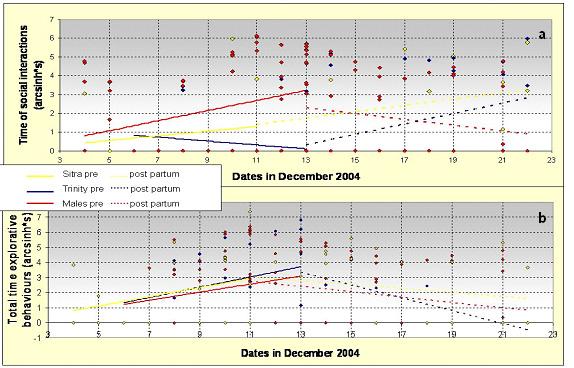Increased intra-pack aggression in canines: a reason for infanticide?
The African wild dogs (Lycaon pictus) as a model species
During modern time there has been many problems to breed different species of canines in zoos and other captive environments and one of the problems reported is the killing (i.e. infanticide) of offspring.(1),(2)
This has also been the case for the African wild dog (Lycaon pictus) and as for other canines the reasons for infanticides are not known.(1),(2),(3) There have been speculations of the proximity of the male, since captive environments usually are small, but also about how the dens should be constructed and if stress was inflicted by humans. Recently two births from young L. pictus females went wrong in Kolmården, but events before and after deliveries may help to explain why infanticide occurred.
Recently dens were built at Kolmården Zoo, Sweden, to house the litters from both the alpha female (Sitra) and the beta/omega female (Trinity), which gave birth to eight respectively one (known) cub during the first part of December 2004. The litters were unfortunately lost: Sitra was not able to give any milk to her litter and she also killed her sister’s litter. Activities during both the period before the delivery (pre partum) and the period after the deliveries (post partum) were monitored and an ethological evaluation as well as an assessment of the new den construction were done, which may have given the answers to why these particular births went wrong.
Throughout the pre partum period, which was monitored from the 4th of December, there was an increased trend (Figure 1a) towards longer social interactions for the male group (P<0,001), most likely initiated by the alpha female. The submissive and dominant behaviours during social interactions are well documented in wolfs (Canis lupus) (4) and visual communication in L.picus is virtually the same. However, it is well documented that social group interactions are more inconspicuous in L.pictus, with fewer and shorter social gatherings.(5) That made the increasing trend especially interesting, but it was even more noticeable that at the same time the beta/omega female’s social time decreased. The decrease was not significant but when combining the information from post partum there was a significantly increased trend (P<0,05) towards longer social periods (Figure 1a), making this trend quite different from the pre partum trend (P<0,10). From video material the social interactions contained many events where the alpha female as well as the males attacked the beta/omega female and the question arise why that happened; what triggered the aggression?
According to what can be seen on tapes all dogs respond to new smells in the indoor facilities pre partum, seen as an increasing trend of explorative behaviours directed to known urine marks, and the logical assumption was that all dogs, and most important the alpha female, could smell the current reproductive status (Figure 1B). These increase in exploration, as well as the social events probably also affected the general activity increase which was especially clear for the males (Standing: P<0,01; Moving: P<0,001), but again there was the opposite (negative) trend for Trinity. The enriching effect of the new smells was only statistically significant for the male group (P<0,01) and also Trinity (P<0,01), but if looking at the trend in Figure 1B there were few doubts about weather Sitra actually could smell her sister’s reproductive status. This suggested why the aggression level increased and this in turn may also explain why Sitra killed Trinity’s offspring: The alpha did not want competition. The conclusion from this was that to reassure a calm alpha the beta/omega female should not be allowed to have cubs at the same time.
In nature it is known that other females than the alpha can get offspring at the same time, but they rarely survive and the reasons for the deaths are usually unknown.(6) There has also been reports about alphas taking other females offspring to raise themselves but also stories about females that share the same den.(5) To keep in mind is that packs of L. pictus have enormous home ranges (6) and that the regularly reported infanticide in captivity may be an effect of experienced high density.

The straw beds on top of a wooden floor inside the new dens at Kolmården zoo were sub-optimal and instead an earthen or sand floor should be used, thus providing a good substrate for digging when birth is imminent, common for many canines.(1),(3) Also the height to the roof should be adjusted, preferably with a Plexiglas® (at 45 cm), making the den more the size of a normal fox hole, but at the same time it would be possible to still record events inside. A smaller den is known to calm other canines (e.g. Red fox (Vulpes vulpes).(1)
If both practical as well as ethological requirements described can be met, this would provide the fundamental factors for many successful deliveries both in zoos and for commercial breeders.
Daniel Rothנ
◊ Department of Biology, IFM, Linköping University,58183 Linköping,
† Kolmården zoo, 618 92 Kolmården(1) Naaktgeboren, C. 1968. Some aspects of parturition in wild and domestic Canidae, International Zoo Yearbook 8: 8-13
(2) Encke, W. 1962. Hand-rearing Cape hunting dogs (Lycaon pictus) at the Krefeld zoo. International Zoo Yearbook 4: 292-293
(3) Cade, C.E. 1967. Notes on breeding the Cape hunting dog (Lycaon pictus) at Nairobi Zoo. International zoo yearbook 7: 122-123.
Responsible for this page:
Director of undergraduate studies Biology
Last updated:
05/30/05
